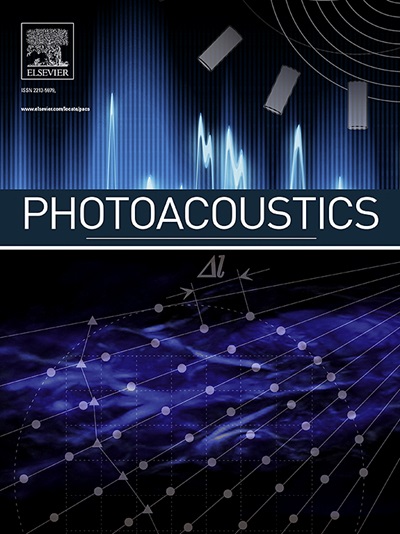石英音叉表面安装装置的光致热弹性光谱
IF 6.8
1区 医学
Q1 ENGINEERING, BIOMEDICAL
引用次数: 0
摘要
本文报道了一种利用表面贴装石英音叉(SMD QTF)和光致热弹性光谱(LITES)技术检测痕量乙炔(C2H2)气体的系统,并与传统插入式石英音叉(P-QTF)进行了对比分析。SMD QTF是一种具有成本效益的标准仪器,具有透明的玻璃外壳和更小的尺寸,这消除了在LITES中剥离外壳的需要,并有效地减轻了QTF的氧化和共振频率的漂移。SMD QTF的Q因子几乎是传统裸P-QTF的2-4倍。实验表明,SMD-QTF的信号幅值比传统裸P-QTF高出近9倍。在相同的实验条件下,两者的最小检出限分别为68.11 ppb@220 s (P-QTF)和40.39 ppb@200 s(较大的SMD QTF)。本文章由计算机程序翻译,如有差异,请以英文原文为准。
A light-induced thermoelastic spectroscopy using surface mounted device quartz tuning fork
This paper reported on a system for the detection of trace acetylene (C2H2) gas utilizing a surface mounted device quartz tuning fork (SMD QTF) in conjunction with light-induced thermoelastic spectroscopy (LITES) and provided a comparative analysis against a conventional plug-in quartz tuning fork (P-QTF). The SMD QTF is a cost-effective standard instrument featuring a transparent glass shell and smaller size, which eliminates the need for stripping shell in LITES and effectively mitigates oxidation of the QTF as well as drift in resonance frequency. The SMD QTF has almost 2–4 times more Q factor than the conventional bare P-QTF. Experiments demonstrated that the signal amplitude of the SMD-QTF was almost 9 times higher than that of the conventional bare P-QTF. Minimum detection limits (MDLs) of 68.11 ppb@220 s (P-QTF) and 40.39 ppb@200 s (Larger SMD QTF) were obtained for both under the same experimental conditions.
求助全文
通过发布文献求助,成功后即可免费获取论文全文。
去求助
来源期刊

Photoacoustics
Physics and Astronomy-Atomic and Molecular Physics, and Optics
CiteScore
11.40
自引率
16.50%
发文量
96
审稿时长
53 days
期刊介绍:
The open access Photoacoustics journal (PACS) aims to publish original research and review contributions in the field of photoacoustics-optoacoustics-thermoacoustics. This field utilizes acoustical and ultrasonic phenomena excited by electromagnetic radiation for the detection, visualization, and characterization of various materials and biological tissues, including living organisms.
Recent advancements in laser technologies, ultrasound detection approaches, inverse theory, and fast reconstruction algorithms have greatly supported the rapid progress in this field. The unique contrast provided by molecular absorption in photoacoustic-optoacoustic-thermoacoustic methods has allowed for addressing unmet biological and medical needs such as pre-clinical research, clinical imaging of vasculature, tissue and disease physiology, drug efficacy, surgery guidance, and therapy monitoring.
Applications of this field encompass a wide range of medical imaging and sensing applications, including cancer, vascular diseases, brain neurophysiology, ophthalmology, and diabetes. Moreover, photoacoustics-optoacoustics-thermoacoustics is a multidisciplinary field, with contributions from chemistry and nanotechnology, where novel materials such as biodegradable nanoparticles, organic dyes, targeted agents, theranostic probes, and genetically expressed markers are being actively developed.
These advanced materials have significantly improved the signal-to-noise ratio and tissue contrast in photoacoustic methods.
 求助内容:
求助内容: 应助结果提醒方式:
应助结果提醒方式:


